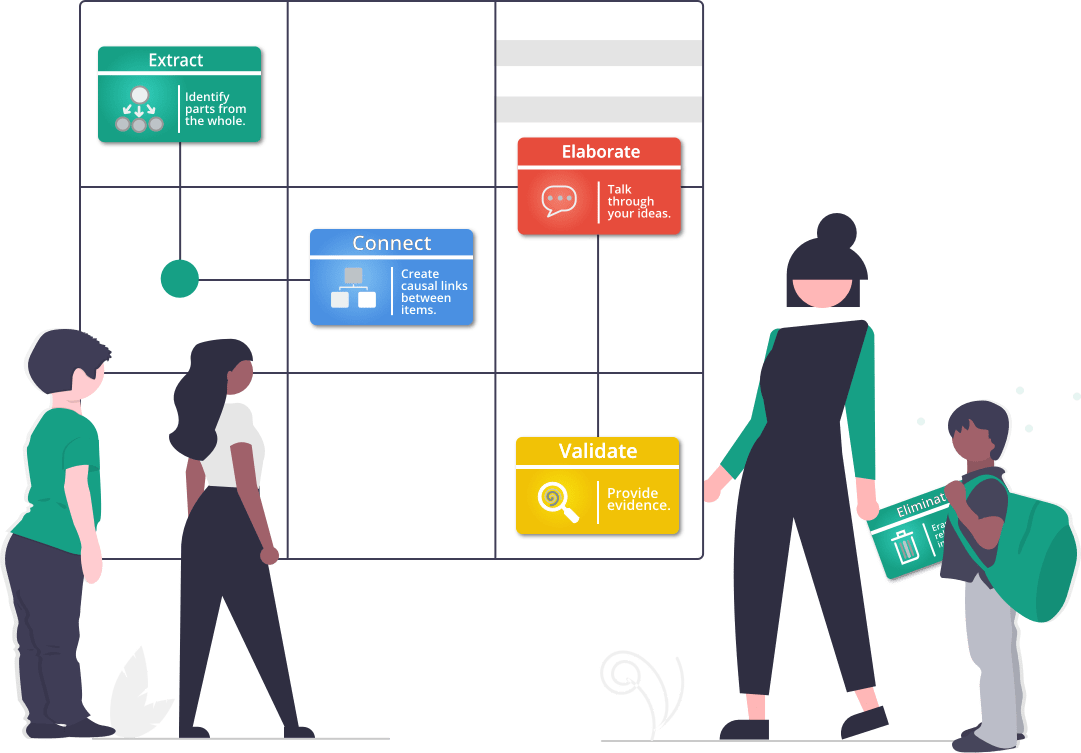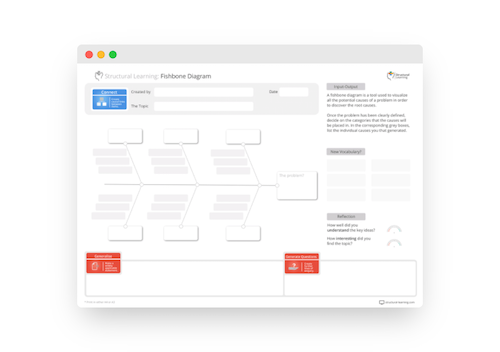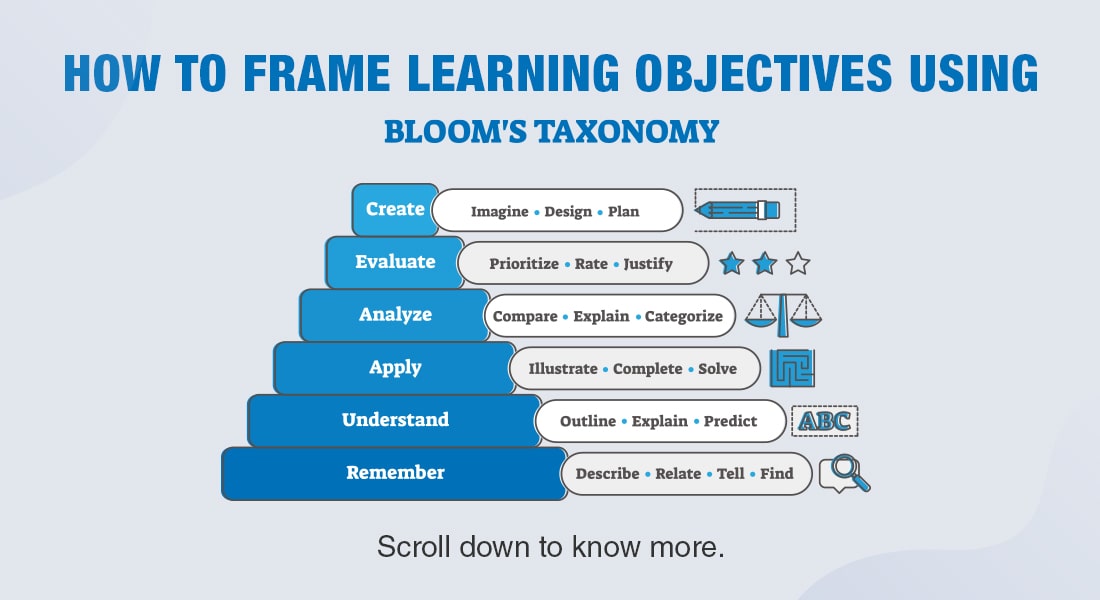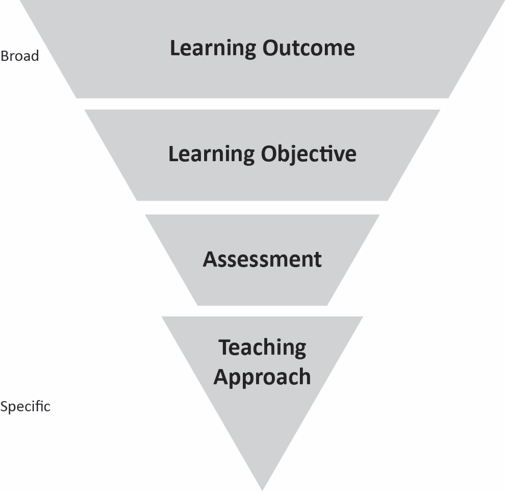Writing Effective Learning Objectives: A Practical Guide for Teachers
Master the art of writing clear, measurable learning objectives. Learn about Bloom's Taxonomy, success criteria, and how to share learning intentions effectively with students.


Master the art of writing clear, measurable learning objectives. Learn about Bloom's Taxonomy, success criteria, and how to share learning intentions effectively with students.
Learning objectives are specific statements that describe what students will know, understand, or be able to do by the end of a lesson. They serve as the foundation for effective teaching by guiding instructional decisions, communicating expectations to students, and enabling meaningful assessment of learning outcomes.
Clear learning objectives are the foundation of effective teaching. They communicate what students will learn, guide instructional decisions, and enable meaningful assessment. Well-crafted objectives use action verbs from Bloom's Taxonomy, focus on what students will know or be able to do, and connect to measurable success criteria. This guide shows you how to write learning objectives that genuinely support learning, rather than becoming a box-ticking exercise that adds little value to your lessons.
In this discussion, we examine the core of these objectives, offering new perspectives on how to design them effectively. We contrast traditional approaches with modern strategies including AI literacy for crafting objectives that give students a clear sense of their learning goals.
Objectives act like a compass, steering lesson planning. They must balance being specific enough to guide learning, while still flexible enough to apply to various contexts. When creating objectives, consider: What key concept am I teaching? What is the goal of this lesson? What should students take away?
Once you answer these questions, you can outline your objectives. For example, a simple statement like, "Today we'll learn how to use a food processor," is a good starting point, but it’s vague. Breaking it down into steps clarifies the lesson’s focus, such as understanding the machine’s operation, its uses, and its benefits.
Each aspect of this process can be taught separately. If the lesson involves using a food processor, it would include operating, cleaning, and preparing food for processing. Similarly, a lesson on using an electric mixer might focus on mixing techniques and ingredient measurements.
In developing objectives, remember that you’re teaching both skills and concepts. A lesson on baking a cake, for instance, could cover techniques like beating eggs, measuring flour, and mixing ingredients. This detailed approach builds not just knowledge, but also confidence in students’ ability to apply what they’ve learned.
Learning objectives serve as the guiding compass in the educational journey, and they can manifest in various forms, each with its unique focus and scope:
Consider this example: In a history class, a lesson level objective might be "Understand the causes of World War II." This objective is part of a unit objective, "Analyze the major events and figures of World War II." Both of these fall under the course level objective, "Develop a comprehensive understanding of 20th-century world history." And all of these contribute to the school-year objective, "Demonstrate critical thinking and analytical skills in understanding historical events and their impacts."
These different forms of learning objectives, each with its unique focus and scope, work together to create a cohesive and comprehensive learning experience.

Start by identifying the key concept and determining what students should be able to do with that knowledge using specific action verbs from Bloom's Taxonomy. Focus on observable behaviors rather than vague intentions, ensuring each objective is measurable and directly aligned with your assessment methods. The best objectives clearly communicate the expected performance, conditions, and criteria for success.
Crafting purposeful lesson objectives is an art that can significantly enhance the learning experience. Here are five top tips to guide you in this process:
Remember, well-crafted lesson objectives serve as the foundation for effective teaching and meaningful learning. They set the direction for your course and provide a clear path for your students to follow. For more insights, consider exploring this academic source on the importance of clear learning objectives.

Replace vague statements like 'understand the topic' with precise cognitive actions using the Universal Thinking Framework, such as 'analyze the causes of' or 'evaluate the effectiveness of.' Break down broad goals into smaller, observable behaviors that show exactly what thinking skills students will use. This specificity helps students know exactly what success looks like and how to achieve it.
The universal thinking framework has become popular partly because of its concrete actions are easy to understand. Children can sometimes get lost in complex language which prevents them from accessing the core content. The framework has been used by schools to help them design robust learning experiences. Predominantly, it has been adopted to build lasting conceptual knowledge in subject-specific domains.
In the UK, the amount of knowledge that a student is expected to understand and remember has increased significantly. As we see it, the only way to advance learning outcomes is to adopt metacognitive knowledge about how we all understand and remember information. The domain of cognitive science provides us with some broad principles that can be transformational in classroom settings.
This mental procedural knowledge enables students to take control of their learning and work more independently. To remember the vast amounts of factual knowledge in any given subject requires a robust understanding of how to organise and use information. Blooms Taxonomy provided classes with lesson level verbs and that could be used to identify the 'level' of learning. The universal thinking framework builds on this idea but provides more specific guidance about the nature of the cognitive domain the learner is working in. This is particularly useful when designing assessment methods and schemes of work.
The lesson level verbs can be used as 'academic stepping stones' that gradually increase cognitive skill levels. The block building methodology that we have been researching enables learners to build structural knowledge. This means the systematic building of schema in the student's mind. The factual knowledge is connected into larger frameworks of understanding which increases the likelihood of curriculum content being both understood and remembered.
 scaffolding the learning objectives" width="auto" height="auto" id="">
scaffolding the learning objectives" width="auto" height="auto" id="">
Effective learning objectives are the cornerstone of any successful educational endeavor. They provide a clear roadmap for both the teacher and the students, outlining what is expected to be achieved as a result of instruction. Here are the key features that make a learning objective effective:
Remember, well-crafted learning objectives serve as the foundation for effective teaching and meaningful learning. They set the direction for your course and provide a clear path for your students to follow.
Strong learning objectives include: 'Students will analyze primary sources to identify three causes of the Civil War' or 'Students will solve quadratic equations using the factoring method with 80% accuracy.' These examples specify the action (analyze, solve), the content (primary sources, quadratic equations), and the success criteria (three causes, 80% accuracy). Each objective clearly states what students will do and how their performance will be measured.
Let's delve into three examples of well-crafted lesson objectives for different age groups, analyzing their strengths and areas for improvement:
1. Kindergarten, Mathematics: "By the end of the lesson, students will be able to identify and name shapes with 90% accuracy."
This objective is clear, measurable, and achievable for this age group. It uses the action verb "identify," which is appropriate for the cognitive process involved. However, it could be improved by specifying the types of shapes to be learned, providing a more precise learning path.
2. Middle School, Science: "Students will demonstrate an understanding of photosynthesis by creating a diagram that illustrates the process, including all major components and steps."
This objective promotes higher-order thinking as it requires students to apply their knowledge to create a diagram. The use of the verb "demonstrate" makes it measurable through the assessment of the diagram. To enhance this objective, the teacher could include a criterion for success, such as "correctly labeling all major components and steps."

3. High School, English: "Students will analyze the use of symbolism in 'To Kill a Mockingbird' and write a one-page essay explaining how it contributes to the overall theme of the novel."
This objective targets higher learning levels, encouraging students to engage in analysis, a higher-order cognitive process. It's specific and measurable, with the one-page essay serving as both the learning activity and the assessment tool. To improve, the objective could specify what aspects of symbolism students should focus on, guiding their learning effort more effectively.
In crafting lesson objectives, teachers should consider Benjamin Bloom's taxonomy, which categorizes cognitive processes from the lowest level (remembering) to the highest (creating).
The choice of action verbs should align with the desired level of learning. Furthermore, the instructional strategy should support the achievement of the educational objectives, and the learning activities should provide a clear and effective learning outcome.
Remember, well-written lesson objectives pave the way for a successful learning journey.

Research shows that clear learning objectives significantly improve student achievement by providing direction and reducing cognitive load during learning. Studies indicate that objectives aligned with assessment and instruction create coherent learning experiences that help students transfer knowledge to new contexts. The most effective objectives balance specificity with flexibility, allowing teachers to adapt while maintaining clear learning targets.
The following studies offer valuable insights into the creation of effective learning objectives using measurable verbs and action-oriented strategies to enhance teaching and learning processes.
1. Chatterjee, D., & Corral, J. (2017). How to Write Well-Defined Learning Objectives.
This paper provides practical guidance on creating specific, measurable learning objectives that align with instructional strategies. It emphasizes the importance of clear, observable action verbs to ensure objectives are achievable and assessable in teaching settings.
2. Nevid, J., & McClelland, N. (2013). Using Action Verbs as Learning Outcomes: Applying Bloom's Taxonomy in Measuring Instructional Objectives in Introductory Psychology.
This study highlights the use of action verbs from Bloom’s taxonomy to evaluate student learning. The research found that measurable verbs aligned with higher-level cognitive skills help distinguish between stronger and weaker students, emphasizing the role of well-written learning objectives in assessing knowledge.
3. Ballard, A. (1990). Getting Started: Writing Behavioral Objectives.
Ballard discusses the importance of writing learning objectives in behavioral terms that are learner-centered. The study outlines the use of measurable verbs to describe expected student behaviors, providing a foundation for teaching objectives that enhance understanding and learning outcomes.
4. Whittington, M. (2005). Writing Objectives in Secondary Agriculture Courses That Challenge Students to Think.
This research outlines strategies for writing objectives using action-oriented and measurable verbs. It emphasizes the importance of challenging students at various cognitive levels through objectives that promote foundational knowledge and critical thinking.
5. DeMers, M. N. (2009). Using Intended Learning Objectives to Assess Curriculum Materials: The UCGIS Body of Knowledge.
DeMers examines the range of cognitive levels suggested by learning objectives in the field of geographic information science. The study highlights the need for well-written learning objectives that ensure clearer understanding and provide measurable learning outcomes in education.
Learning objectives are specific statements that describe what students will know, understand, or be able to do by the end of a lesson. They serve as the foundation for effective teaching by guiding instructional decisions, communicating expectations to students, and enabling meaningful assessment of learning outcomes.
Clear learning objectives are the foundation of effective teaching. They communicate what students will learn, guide instructional decisions, and enable meaningful assessment. Well-crafted objectives use action verbs from Bloom's Taxonomy, focus on what students will know or be able to do, and connect to measurable success criteria. This guide shows you how to write learning objectives that genuinely support learning, rather than becoming a box-ticking exercise that adds little value to your lessons.
In this discussion, we examine the core of these objectives, offering new perspectives on how to design them effectively. We contrast traditional approaches with modern strategies including AI literacy for crafting objectives that give students a clear sense of their learning goals.
Objectives act like a compass, steering lesson planning. They must balance being specific enough to guide learning, while still flexible enough to apply to various contexts. When creating objectives, consider: What key concept am I teaching? What is the goal of this lesson? What should students take away?
Once you answer these questions, you can outline your objectives. For example, a simple statement like, "Today we'll learn how to use a food processor," is a good starting point, but it’s vague. Breaking it down into steps clarifies the lesson’s focus, such as understanding the machine’s operation, its uses, and its benefits.
Each aspect of this process can be taught separately. If the lesson involves using a food processor, it would include operating, cleaning, and preparing food for processing. Similarly, a lesson on using an electric mixer might focus on mixing techniques and ingredient measurements.
In developing objectives, remember that you’re teaching both skills and concepts. A lesson on baking a cake, for instance, could cover techniques like beating eggs, measuring flour, and mixing ingredients. This detailed approach builds not just knowledge, but also confidence in students’ ability to apply what they’ve learned.
Learning objectives serve as the guiding compass in the educational journey, and they can manifest in various forms, each with its unique focus and scope:
Consider this example: In a history class, a lesson level objective might be "Understand the causes of World War II." This objective is part of a unit objective, "Analyze the major events and figures of World War II." Both of these fall under the course level objective, "Develop a comprehensive understanding of 20th-century world history." And all of these contribute to the school-year objective, "Demonstrate critical thinking and analytical skills in understanding historical events and their impacts."
These different forms of learning objectives, each with its unique focus and scope, work together to create a cohesive and comprehensive learning experience.

Start by identifying the key concept and determining what students should be able to do with that knowledge using specific action verbs from Bloom's Taxonomy. Focus on observable behaviors rather than vague intentions, ensuring each objective is measurable and directly aligned with your assessment methods. The best objectives clearly communicate the expected performance, conditions, and criteria for success.
Crafting purposeful lesson objectives is an art that can significantly enhance the learning experience. Here are five top tips to guide you in this process:
Remember, well-crafted lesson objectives serve as the foundation for effective teaching and meaningful learning. They set the direction for your course and provide a clear path for your students to follow. For more insights, consider exploring this academic source on the importance of clear learning objectives.

Replace vague statements like 'understand the topic' with precise cognitive actions using the Universal Thinking Framework, such as 'analyze the causes of' or 'evaluate the effectiveness of.' Break down broad goals into smaller, observable behaviors that show exactly what thinking skills students will use. This specificity helps students know exactly what success looks like and how to achieve it.
The universal thinking framework has become popular partly because of its concrete actions are easy to understand. Children can sometimes get lost in complex language which prevents them from accessing the core content. The framework has been used by schools to help them design robust learning experiences. Predominantly, it has been adopted to build lasting conceptual knowledge in subject-specific domains.
In the UK, the amount of knowledge that a student is expected to understand and remember has increased significantly. As we see it, the only way to advance learning outcomes is to adopt metacognitive knowledge about how we all understand and remember information. The domain of cognitive science provides us with some broad principles that can be transformational in classroom settings.
This mental procedural knowledge enables students to take control of their learning and work more independently. To remember the vast amounts of factual knowledge in any given subject requires a robust understanding of how to organise and use information. Blooms Taxonomy provided classes with lesson level verbs and that could be used to identify the 'level' of learning. The universal thinking framework builds on this idea but provides more specific guidance about the nature of the cognitive domain the learner is working in. This is particularly useful when designing assessment methods and schemes of work.
The lesson level verbs can be used as 'academic stepping stones' that gradually increase cognitive skill levels. The block building methodology that we have been researching enables learners to build structural knowledge. This means the systematic building of schema in the student's mind. The factual knowledge is connected into larger frameworks of understanding which increases the likelihood of curriculum content being both understood and remembered.
 scaffolding the learning objectives" width="auto" height="auto" id="">
scaffolding the learning objectives" width="auto" height="auto" id="">
Effective learning objectives are the cornerstone of any successful educational endeavor. They provide a clear roadmap for both the teacher and the students, outlining what is expected to be achieved as a result of instruction. Here are the key features that make a learning objective effective:
Remember, well-crafted learning objectives serve as the foundation for effective teaching and meaningful learning. They set the direction for your course and provide a clear path for your students to follow.
Strong learning objectives include: 'Students will analyze primary sources to identify three causes of the Civil War' or 'Students will solve quadratic equations using the factoring method with 80% accuracy.' These examples specify the action (analyze, solve), the content (primary sources, quadratic equations), and the success criteria (three causes, 80% accuracy). Each objective clearly states what students will do and how their performance will be measured.
Let's delve into three examples of well-crafted lesson objectives for different age groups, analyzing their strengths and areas for improvement:
1. Kindergarten, Mathematics: "By the end of the lesson, students will be able to identify and name shapes with 90% accuracy."
This objective is clear, measurable, and achievable for this age group. It uses the action verb "identify," which is appropriate for the cognitive process involved. However, it could be improved by specifying the types of shapes to be learned, providing a more precise learning path.
2. Middle School, Science: "Students will demonstrate an understanding of photosynthesis by creating a diagram that illustrates the process, including all major components and steps."
This objective promotes higher-order thinking as it requires students to apply their knowledge to create a diagram. The use of the verb "demonstrate" makes it measurable through the assessment of the diagram. To enhance this objective, the teacher could include a criterion for success, such as "correctly labeling all major components and steps."

3. High School, English: "Students will analyze the use of symbolism in 'To Kill a Mockingbird' and write a one-page essay explaining how it contributes to the overall theme of the novel."
This objective targets higher learning levels, encouraging students to engage in analysis, a higher-order cognitive process. It's specific and measurable, with the one-page essay serving as both the learning activity and the assessment tool. To improve, the objective could specify what aspects of symbolism students should focus on, guiding their learning effort more effectively.
In crafting lesson objectives, teachers should consider Benjamin Bloom's taxonomy, which categorizes cognitive processes from the lowest level (remembering) to the highest (creating).
The choice of action verbs should align with the desired level of learning. Furthermore, the instructional strategy should support the achievement of the educational objectives, and the learning activities should provide a clear and effective learning outcome.
Remember, well-written lesson objectives pave the way for a successful learning journey.

Research shows that clear learning objectives significantly improve student achievement by providing direction and reducing cognitive load during learning. Studies indicate that objectives aligned with assessment and instruction create coherent learning experiences that help students transfer knowledge to new contexts. The most effective objectives balance specificity with flexibility, allowing teachers to adapt while maintaining clear learning targets.
The following studies offer valuable insights into the creation of effective learning objectives using measurable verbs and action-oriented strategies to enhance teaching and learning processes.
1. Chatterjee, D., & Corral, J. (2017). How to Write Well-Defined Learning Objectives.
This paper provides practical guidance on creating specific, measurable learning objectives that align with instructional strategies. It emphasizes the importance of clear, observable action verbs to ensure objectives are achievable and assessable in teaching settings.
2. Nevid, J., & McClelland, N. (2013). Using Action Verbs as Learning Outcomes: Applying Bloom's Taxonomy in Measuring Instructional Objectives in Introductory Psychology.
This study highlights the use of action verbs from Bloom’s taxonomy to evaluate student learning. The research found that measurable verbs aligned with higher-level cognitive skills help distinguish between stronger and weaker students, emphasizing the role of well-written learning objectives in assessing knowledge.
3. Ballard, A. (1990). Getting Started: Writing Behavioral Objectives.
Ballard discusses the importance of writing learning objectives in behavioral terms that are learner-centered. The study outlines the use of measurable verbs to describe expected student behaviors, providing a foundation for teaching objectives that enhance understanding and learning outcomes.
4. Whittington, M. (2005). Writing Objectives in Secondary Agriculture Courses That Challenge Students to Think.
This research outlines strategies for writing objectives using action-oriented and measurable verbs. It emphasizes the importance of challenging students at various cognitive levels through objectives that promote foundational knowledge and critical thinking.
5. DeMers, M. N. (2009). Using Intended Learning Objectives to Assess Curriculum Materials: The UCGIS Body of Knowledge.
DeMers examines the range of cognitive levels suggested by learning objectives in the field of geographic information science. The study highlights the need for well-written learning objectives that ensure clearer understanding and provide measurable learning outcomes in education.